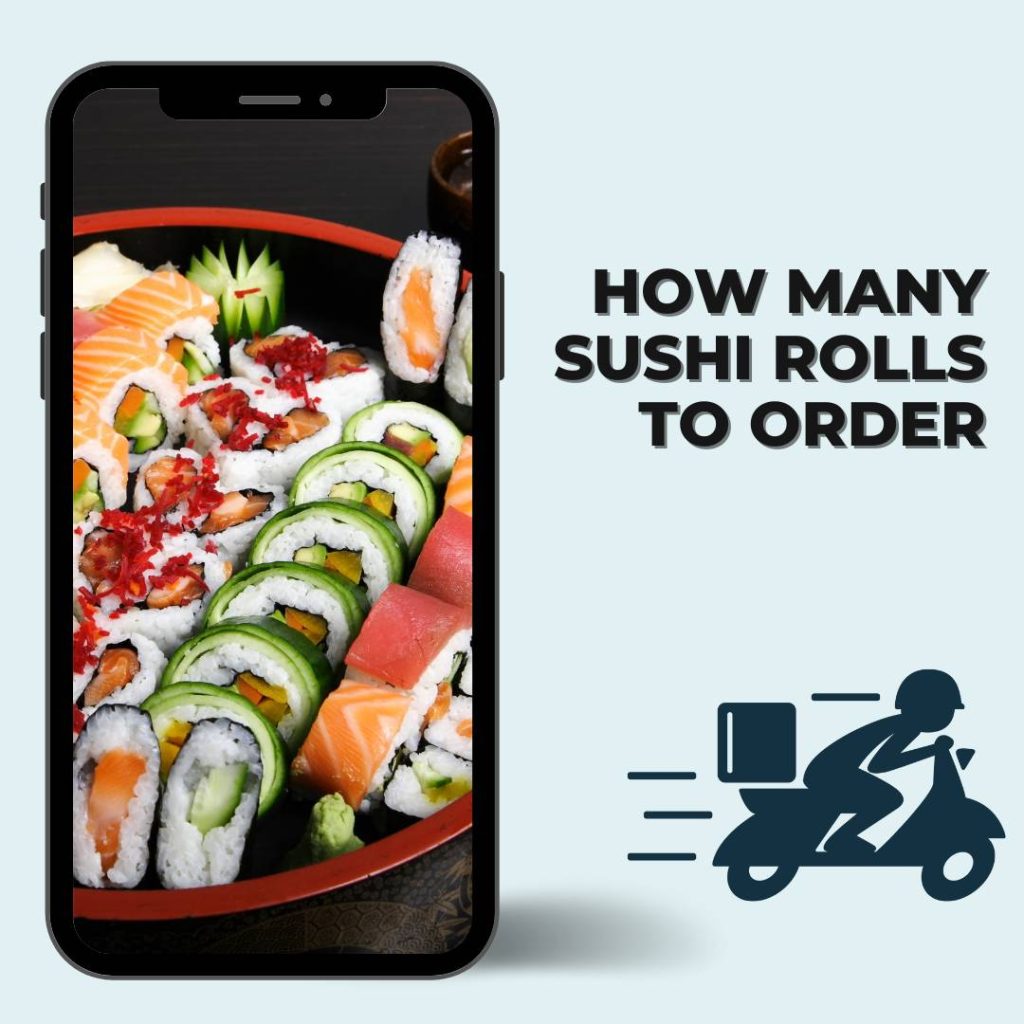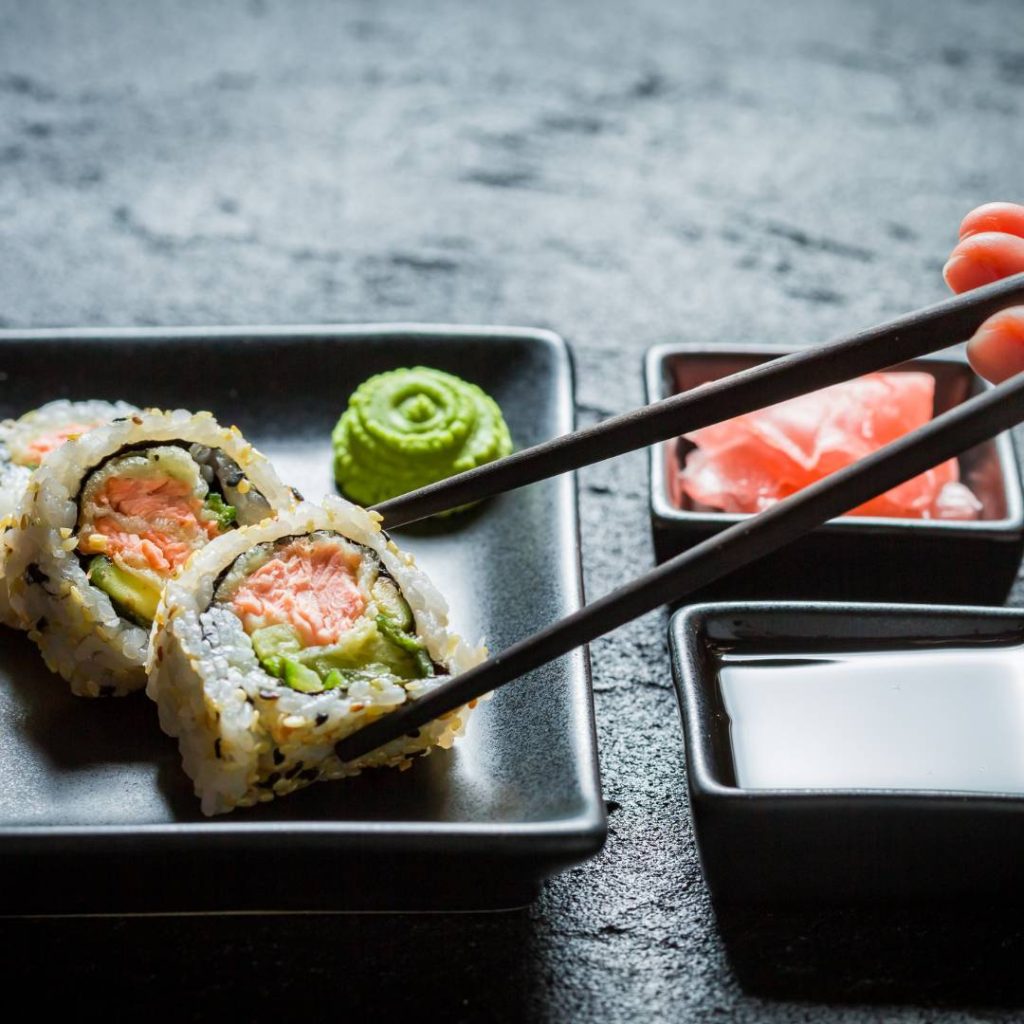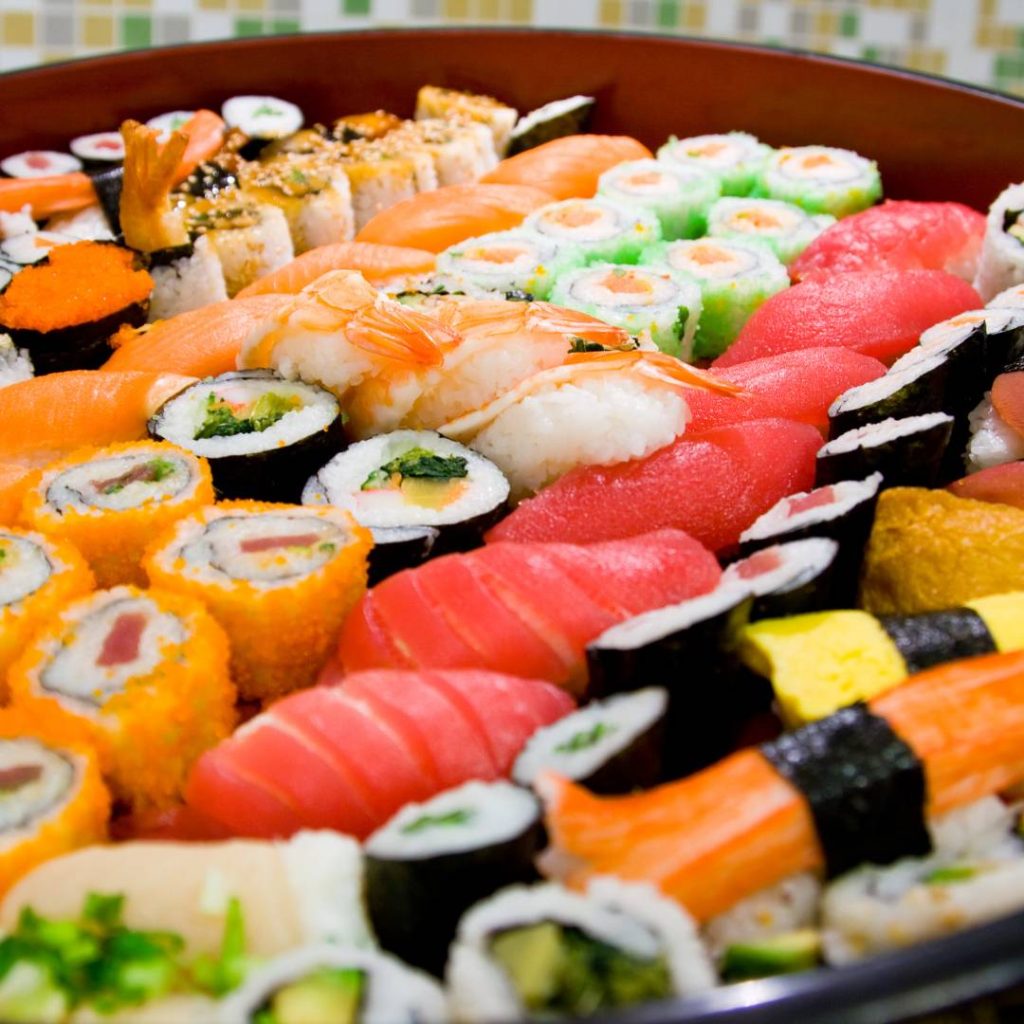Sushi is a Japanese dish that has become increasingly popular around the world. It is a healthy and delicious meal option that can be enjoyed by people of all ages. However, if you’re planning a sushi party or ordering sushi for a group, it’s important to know how many sushi rolls per person are needed to avoid overordering or underordering.
Understanding sushi serving size is crucial when ordering sushi for a group. The number of sushi rolls per person can vary depending on the type of sushi roll and the appetite of the person. Women typically eat six rolls, while men can eat more than eight. However, only two sushi rolls are usually in a serving, and people can typically consume triple the serving size. If side dishes are provided with the sushi, then fewer rolls will be needed.
Key Takeaways
- Understanding sushi serving size is crucial when ordering sushi for a group.
- Women typically eat six rolls, while men can eat more than eight.
- Only two sushi rolls are usually in a serving, and people can typically consume triple the serving size.

Understanding Sushi
Sushi is a traditional Japanese dish that has become popular all over the world. It is a dish made with cooked vinegared rice, combined with various ingredients such as raw fish, vegetables, and seaweed. Sushi is usually served in bite-sized pieces or rolls and accompanied by soy sauce, wasabi, and pickled ginger.
Types of Sushi
There are different types of sushi, each with its unique characteristics. The most common ones are maki, nigiri, and sashimi. Maki sushi is a type of sushi roll that typically contains rice, seaweed (nori), and fillings such as raw fish, vegetables, and avocado. Nigiri sushi consists of a small ball of rice topped with a slice of raw fish or other seafood. Sashimi is thinly sliced raw fish or meat served without rice.
Sushi Ingredients
The ingredients used in sushi vary depending on the type of sushi. The most common sushi ingredients include raw fish, seaweed (nori), cooked vinegared rice, and fillings such as cucumber, avocado, and carrots. Other ingredients used in sushi include wasabi, pickled ginger, and soy sauce.
Sushi Roll Varieties
Sushi rolls come in different sizes and shapes. The most common sushi roll varieties include uramaki, futomaki, and hand rolls. Uramaki is a type of sushi roll that has rice on the outside and seaweed on the inside, with fillings such as avocado and cucumber. Futomaki is a thick sushi roll that typically contains rice, seaweed, and fillings such as cooked egg, cucumber, and pickled vegetables. Hand rolls are cone-shaped sushi rolls that are usually filled with rice, seaweed, and fillings such as raw fish and vegetables.

Sushi Serving Size
When it comes to serving sushi, it’s important to know how much to order to ensure that everyone leaves satisfied. In this section, we’ll discuss the appropriate serving size for sushi and how to calculate it.
Sushi Rolls Per Person
The number of sushi rolls per person can vary depending on several factors such as age, gender, and appetite. According to Cook for Folks, you should plan for seven sushi rolls per person for dinner. Women typically eat six rolls, while men can eat more than eight. However, this can vary depending on the size of the rolls, the appetite of your guests, and whether you’re serving side dishes.
Another source, Ichi Sushi, suggests that a woman will generally require 6-8 rolls, while a male can eat two orders of 8 rolls. Men need twice the quantity of rolls women do. The size of the sushi rolls also matters. If you have larger rolls, you need less of them. However, if the sushi slices are smaller, you will need an immense quantity to feed a large group.
It’s also important to note that the number of pieces of sushi in a roll can vary. A standard sushi roll usually contains 6-8 pieces, but some rolls can contain as many as 10 pieces. If you’re ordering sushi for a group, it’s always better to have a little more than not enough.

Ordering Sushi
If you’re planning to order sushi, it’s essential to know how many sushi rolls per person you should order. Whether you’re ordering sushi for a group or dining at a restaurant, it’s important to ensure that you have enough sushi rolls for everyone.
Ordering Sushi for a Group
When ordering sushi for a group, it’s always better to have a little more than not enough. Generally, you should order at least three sushi rolls per person. If you’re unsure about the number of rolls to order, you can always ask the sushi chef or restaurant staff for guidance.
If you’re ordering sushi for a group, it’s also a good idea to consider the different types of sushi rolls that you want to order. You can include a variety of rolls with different fillings to cater to everyone’s taste preferences. You can also order side dishes like miso soup, edamame, or tempura to complement the sushi rolls.
Ordering Sushi at a Restaurant
If you’re dining at a sushi restaurant, you can order sushi rolls from the menu or the sushi bar. When ordering sushi rolls, you should consider the size of the rolls and the number of pieces per roll. A standard sushi roll usually contains six to eight pieces, while a larger roll may contain four pieces.
If you’re unsure about the number of rolls to order, you can ask the server or the sushi chef for guidance. They can recommend the number of rolls based on the size of your group and your appetite. You can also order different types of sushi rolls to try out new flavors and combinations.
When ordering sushi at a restaurant, it’s important to consider the price and the quality of the sushi rolls. Some sushi restaurants may have higher prices than others, depending on the location and the quality of the ingredients. It’s always better to choose a Japanese restaurant with a good reputation and quality ingredients to ensure that you get the best sushi experience.
Health Aspects of Sushi
Sushi is a popular Japanese dish that has gained worldwide popularity due to its unique taste and health benefits. Sushi is a low-calorie, low-fat, and low-sodium food that can be a healthy addition to your diet. However, there are some potential health risks associated with sushi that you should be aware of.
Nutritional Value
Sushi is a nutrient-dense food that is rich in protein, vitamins, and minerals. The nutritional value of sushi varies depending on the type of sushi you eat. For example, a California roll typically contains avocado, cucumber, crab meat, and rice. This type of sushi is relatively low in calories and fat and provides a good source of fiber, vitamin C, and potassium.
Fresh fish sushi, such as salmon or tuna, is a good source of omega-3 fatty acids, which are essential for brain health and heart health. Omega-3 fatty acids can help reduce inflammation, lower blood pressure, and improve cholesterol levels.
Potential Health Risks
While sushi can be a healthy addition to your diet, there are some potential health risks associated with eating sushi. One of the main concerns is the risk of mercury poisoning. Some types of fish, such as tuna, can be high in mercury, which can be harmful to your health if consumed in large amounts.
Another potential health risk associated with sushi is the risk of foodborne illness. Raw fish and shellfish can contain harmful bacteria and parasites that can cause food poisoning. To reduce the risk of foodborne illness, it is important to choose a reputable sushi restaurant and to make sure that the sushi is prepared and stored properly.
Finally, sushi can be high in sodium, especially if you eat soy sauce with your sushi. High sodium intake can lead to high blood pressure, which can increase your risk of heart disease and stroke. To reduce your sodium intake, you can ask for low-sodium soy sauce or skip the soy sauce altogether.

Sushi Accompaniments
When it comes to sushi, the accompaniments play an important role in enhancing the overall flavor and experience. In this section, we will discuss some of the most common sushi accompaniments, including wasabi, soy sauce, ginger, and vegetables.
Wasabi
Wasabi is a green paste that is often served with sushi. It is made from the root of the wasabi plant and has a pungent, spicy flavor. Wasabi is typically added to soy sauce to create a dipping sauce for sushi. It is important to note that wasabi should be used sparingly, as it can be quite spicy.
Soy Sauce
Soy sauce is a staple condiment in Japanese cuisine and is often served with sushi. It is a salty, savory sauce made from soybeans, wheat, and salt. Soy sauce is typically used as a dipping sauce for sushi and can also be used to flavor other dishes.
When using soy sauce with sushi, it is important to use it in moderation. Too much soy sauce can overpower the flavor of the sushi and make it too salty. It is also recommended to use low-sodium soy sauce to reduce the salt content.
Ginger
Pickled ginger, also known as gari, is often served with sushi. It is made by pickling thin slices of ginger in vinegar and sugar. Ginger is typically eaten between different types of sushi to cleanse the palate and enhance the flavor of the sushi.
Vegetables and Other Fillings
Vegetables such as cucumber, avocado, and daikon radish are often used as fillings in sushi. These vegetables add texture and flavor to the sushi and can also provide a healthy alternative to fish-based sushi.
Other fillings such as cream cheese and green onions can also be used in sushi. These ingredients add a unique flavor and texture to the sushi and can be a great option for those who do not enjoy raw fish.
In addition to these accompaniments, other tools such as a bamboo mat and chopsticks can be used to enhance the sushi experience. Overall, the accompaniments play an important role in creating a well-balanced and flavorful sushi dish.

Sushi Party Planning
If you’re planning a sushi party, one of the essential things to consider is how many sushi rolls to order. You don’t want to order too few rolls and leave your guests hungry, but you also don’t want to order too many and end up with a lot of leftovers. In this section, we’ll discuss how many sushi rolls to order and how to avoid leftovers.
How Many Sushi Rolls to Order
When it comes to sushi rolls, the amount you need per person can vary depending on a few factors. As a general rule, it’s best to order at least three rolls per person. However, if you’re serving other dishes or sides, you can reduce the number of rolls you order.
If you’re serving unique flavors or seafood, keep in mind that some sushi lovers may eat more than others. Additionally, if you’re having a buffet-style sushi party, you may need to order more rolls to accommodate guests who go back for seconds.

Konnichiwa! (Hello!) I'm Pat Tokuyama, a Japanese tofu cookbook author, who travels for music, food, and adventure. If you like Japanese tea, checkout some of the newestorganic japanese tea, matcha bowls and noren and more!
** Curious about the Plant Based Japanese Cooking Club? ** Learn more here!
Avoiding Leftovers
While it’s better to have more sushi rolls than not enough, you don’t want to end up with a lot of leftovers. To avoid waste, consider these factors when ordering:
- The number of guests: Make sure you have an accurate headcount before ordering sushi rolls.
- Dietary restrictions: If you have guests with dietary restrictions, such as vegetarians or those who don’t eat seafood, you may need to order more vegetables or California rolls.
- Other dishes: If you’re serving other dishes or sides, you can reduce the number of sushi rolls you order.
- Sushi rice: Keep in mind that sushi rice can be filling, so you may not need as many rolls if you’re serving larger portions of rice.
By considering these factors, you can order the right amount of sushi rolls to avoid waste and ensure your guests are satisfied.











Konnichiwa! (Hello!) I'm Pat Tokuyama, a Japanese tofu cookbook author, who travels for music, food, and adventure. If you like Japanese tea, checkout some of the newestorganic japanese tea, matcha bowls and noren and more!
** Curious about the Plant Based Japanese Cooking Club? ** Learn more here!